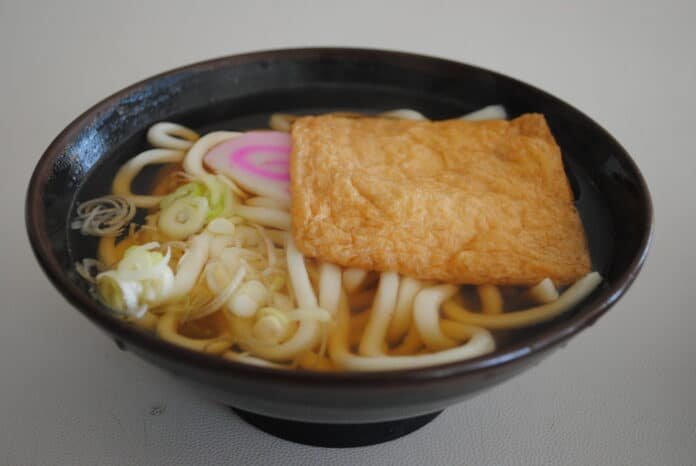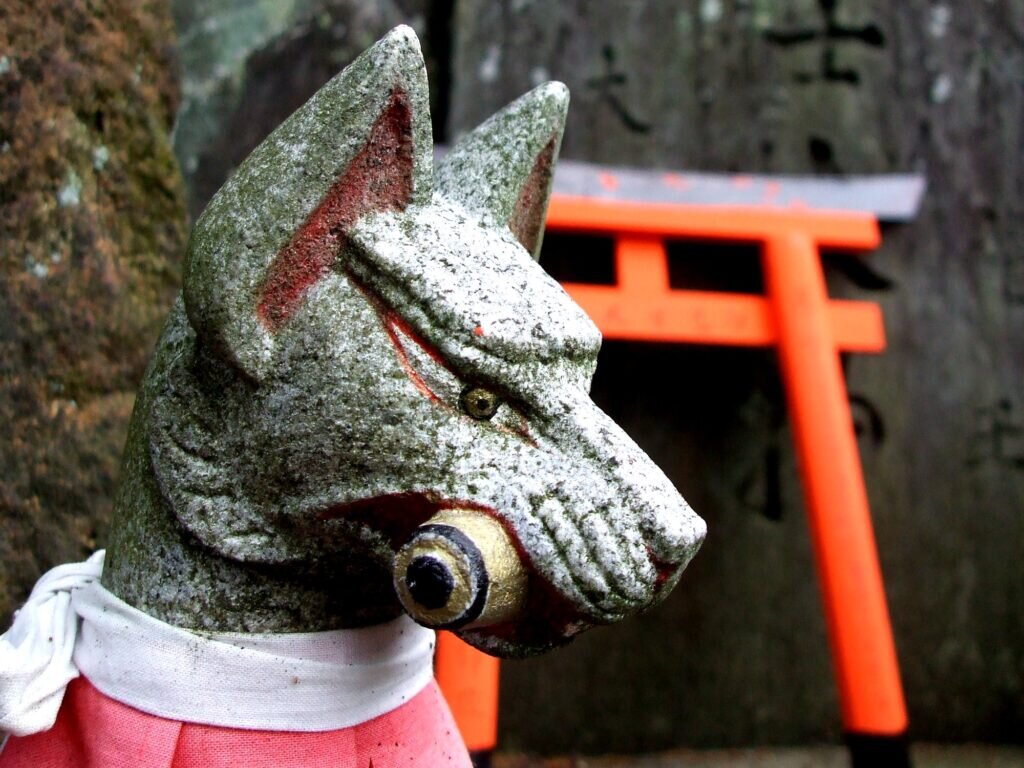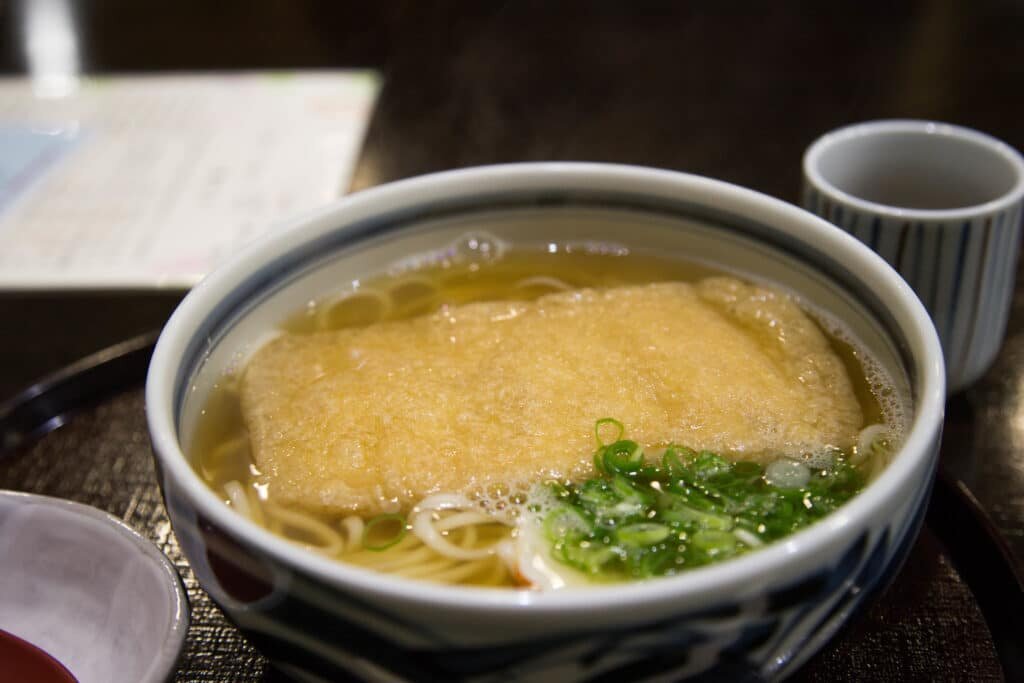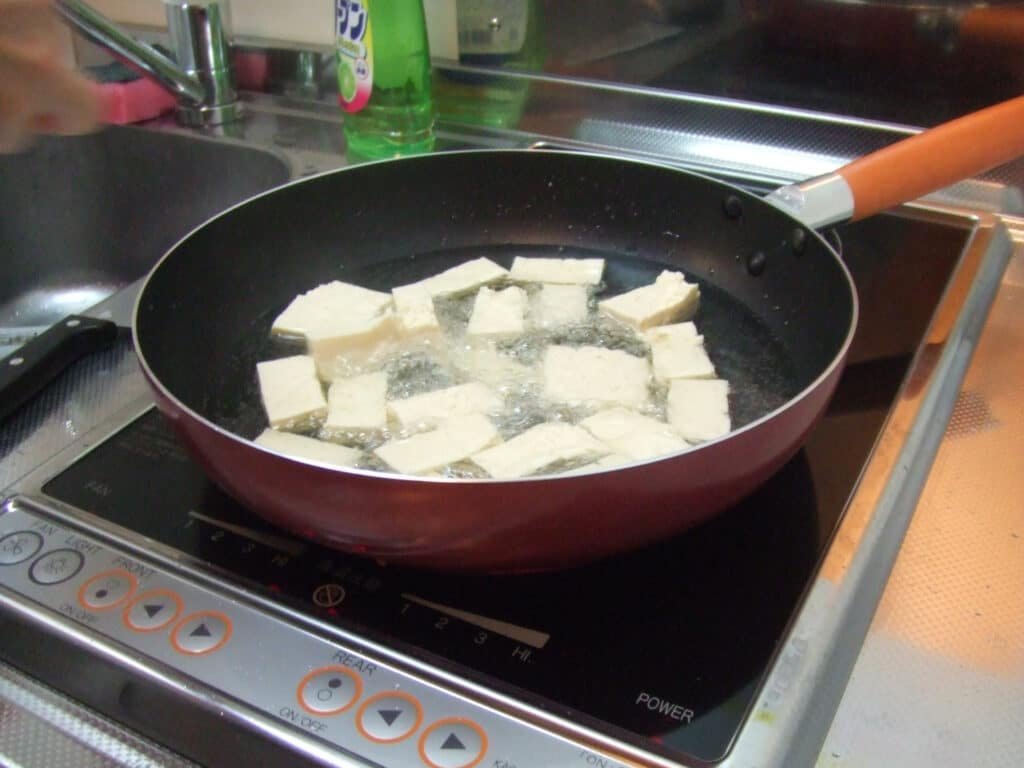
A bowl of udon noodles is one of those Japanese foods that’s always welcome, any time of the day. Whether it is as part of a hearty breakfast, to set you up for a long and grueling day at work, as a lunch to get you through the day or even as part of a sumptuous dinner to cap off another day’s work well done, there are very people in Osaka, or indeed all over Japan who don’t love a good bowl of udon. Kitsune Udon Osaka
Osaka has its own take on this ever-popular dish, and we call it Kitsune Udon.
What is Kitsune Udon?

The difference between Kitsune Udon and a conventional bowl of udon noodles lies in the addition of one simple, yet delicious extra element: A large slab of seasoned tofu, usually rectangular in shape, which softens as it soaks in the soup base alongside the noodles.
This tofu is also the source from which Kitsune Udon derives its name.
In Japanese, “Kitsune” means “fox”. According to Japanese legend and traditions, the seasoned tofu which is added to udon bowls to create Kitsune Udon is said to be a fox’s favourite food.
Quite how a fox would get its paws on seasoned tofu is a mystery to me, but if there’s one thing the Japanese love, it’s a good old folk tale about animals!
The fried tofu used in preparing Kitsune Udon is almost identical to that used in Inarizushi, a type of sushi made by placing mounds of sushi rice inside pockets of soft, fried tofu.
The exact origin of Kitsune Udon is unknown, but it is widely thought to have originated in Osaka during the late Edo period.
Varieties of Kitsune Udon

The manner in which Kitsune Udon is prepared is somewhat fixed. It is, basically speaking, a regular bowl of udon noodles with the addition of the slab of aforementioned soft, fried tofu.
However, what constitutes a regular bowl of udon is, of course, up for debate. As such, you will find a number of variations on the theme, depending on where you go.
Many bowls of Kitsune Udon will contain the narutomaki sliced fish cake (characterized by its disk shape and pink swirl pattern). Others may contain spring onions, and some may have both.
There is a similar dish to Kitsune Udon called Tanuki Udon. Tanuki means raccoon in Japanese. It is important not to confuse the two.
The difference between Kitsune and Tanuki udon is that whearas Kitsune uses a fried tofu slice, Tanuki Udon substitutes this for pieces of pre-fried tempura batter.
Tanuki Udon is a delicious dish in its own right though, and I would recommend you try it sometime. However, in my own opinon, Kitsune Udon is just that little bit better.
Where to buy Kitsune Udon

Without a doubt, the best place to sample Kitsune Udon is in a good, old fashioned noodle bar. You’ll find these dotted all over Osaka.
However, my personal favourite is Ibuki Udon, located in Kita Ward, about ten minutes walk from Tenma station.
Yes, it is a little bit out of the way, but trust me when I say it is well worth it.
I’m certainly no stranger to a good bowl of noodles both as a means to start and end a good night out in Osaka, and I can say without doubt that, when it comes to Kitsune Udon, Ibuki Udon is up there with the very best of them. It’s cheap, it’s simple, and it is absolutely delicious!
How to make Kitsune Udon

Kitsune Udon is a delicious, distinctively Japanese dish, but it’s also very easy to make.
So, to impress your friends and family with your very own Kitsune Udon, you’ll need the following ingredients:
1 large slice of aburage (the fried tofu used in Kitsune Udon, usually available in packs of three or five from Asian supermarkets).
1 tablespoon of sugar
2 tablespoons of sake (red wine vinegar will also work)
1 tablespoon of light soy sauce
2 packs of Udon Noodles
3 tablespoons of Dashi (chicken or fish stock also makes a reasonable substitute).
Fish balls, finely sliced.
Table of Contents
Steps in making kitsune udon
Spring onions, finely chopped.
Begin by pan-boiling your aburage for about 1 minute. Using a spoon or fork, apply gentle pressure to the top of your aburage to squeeze out any excess water, but be careful not to press too hard that you break the aburage itself.
Remove the aburage from the pan, slice it in half and set it aside for now.
Pour the water out of your pan and wipe it clean.
Next, add your sake, soy sauce, sugar and about 2 tablespoons of water, simmer gently.
Once the mix has come to the boil, add the aburage back in and simmer gently, turning occasionally. Do this until most or all of the mixture has absorbed into your tofu.
Next, add you stock and udon noodles to a pot, heat gently until soft, adding your vegetables and fish balls halfway through. Once the whole mix has heated through and both the udon noodles and the accompaniments are as soft as you like them, serve the mix into to bowls.
Finally, top these bowls off with a slice of aburage each, and your Kitsune Udon is ready to serve!





















[…] https://www.osaka.com/eat/kitsune-udon/kitsune-udon-osakas-foxiest-food/ […]